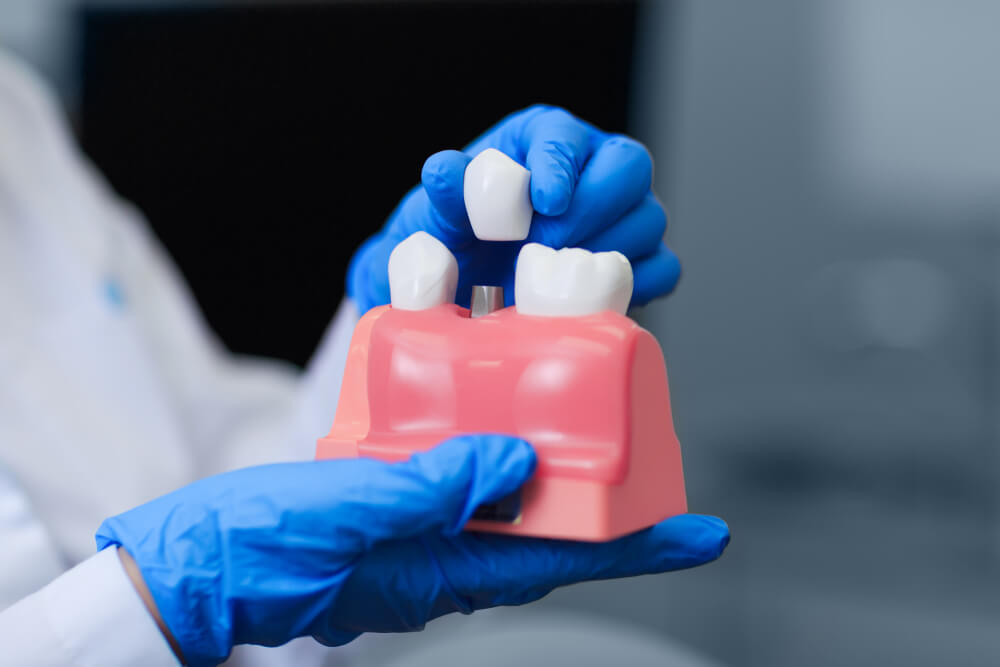
Dental restoration includes a variety of dental procedures used to restore the function of a tooth by replacing missing or damaged tooth structure.
Fillings – When treating a cavity, your dentist will remove the decayed portion of your tooth and fill it with another substance. There are multiple options for the material to be used in the filling, the most common of which are composite fillings and amalgam fillings.
Composite Filling or Dental Bonding – A composite filling is also known as a tooth colored filling since the material used in the filling can be closely matched to the color of your teeth. Composite fillings provide durability for small to medium cavities. They are also particularly well suited for treating front or highly visible teeth because of their natural look. A composite filling can be used to restore a cavity in a decaying tooth, to repair a chipped tooth or broken tooth, to replace amalgam fillings or for decreasing the gap between teeth with dental bonding.
Amalgam filling – Amalgam fillings (sometimes referred to as “silver fillings” because of their color), once the standard in cavity restoration, are now used quite sparingly. An amalgam may be used in an area that cannot be kept dry enough to place a composite filling. Amalgam fillings are effective in filling cavities in a moist environment.
Amalgam filling removal – Because amalgam fillings were so popular in years past, many patients have numerous amalgam restorations. For any number of reasons patients may want to replace amalgam fillings with tooth-colored, composite fillings. Some patients are concerned that the amalgam fillings don’t last as long as composite fillings, other patients are worried about the tooth cracking or chipping because amalgam fillings don’t bond to the tooth structure like composite fillings, some fear the mercury filling material that is present in small amounts in amalgam, but most patients simply want to remove the silver fillings from their teeth because they don’t look as nice. Your dentist can evaluate your amalgam fillings and prepare a plan for the gradual or immediate replacement with composite fillings.
Dental Veneers – Front teeth that are badly stained, misshaped teeth or crooked teeth may be improved by veneers placed on the surface of the affected teeth.
Veneers are thin pieces of porcelain or other material cemented over the front of your teeth to change their color or shape. Veneers have a longer life expectancy and color stability than bonding, and highly resist permanent staining.
Dental veneers can mask undesirable defects, such as teeth stained by tetracycline or injury and are ideal for masking discolored fillings in front teeth. Patients with gaps between their front teeth or teeth that are chipped or worn may also consider porcelain veneers.
Dental Crown – Over time our teeth begin to weaken and become more susceptible to problems such as cavities, cracking and discoloration. If your dentist observes a tooth that is decayed, weakened or cracked a crown may be a good option. A crown can also restore a tooth that has had a root canal or replace a large filling to prevent a broken tooth.
To prepare a tooth for a crown, your dentist simply removes a layer of the tooth surface to accommodate the thickness of the crown. A crown is created and cemented onto the remaining tooth surface and your bite is adjusted for a proper relationship with the teeth it touches.
Your crown will be tooth-colored to blend in and appear just like one of your natural teeth. Crowns are durable and will usually last about 10-15 years. You should care for it as you would any of your other teeth by following the recommendations of your dentist and dental hygienist.
Dental Bridge – Bridges are a natural-looking replacement for one or more missing teeth. Because they are custom-made, bridges are barely noticeable and can restore the natural contour of teeth as well as the proper bite. Your existing teeth are used to literally create a bridge to cross the area where your tooth is missing. Bridges are made from porcelain, gold, or metal alloys to ensure that they are strong and durable.
The teeth on either side of the missing tooth are recontoured to provide a base for the bridge (similar to a crown preparation). A dental laboratory is able to create a bridge that will fit properly and feel as close to your natural teeth as possible. The bridge is then cemented into place. Your dental bridge may take a little while to get used to, but after a few days it should feel like you have your own teeth back again.
If you are missing a tooth you should consider having it replaced. Besides the aesthetic disadvantage of missing a tooth, it could also cause structural changes to your mouth and jaw, as well as making it difficult to eat or speak properly. Set up an appointment today to restore your smile.
Dental Implant – Before development of dental implants, dentures and bridges were the only alternatives to replacing a missing tooth or teeth. Dental Implants are titanium replacements for teeth that are anchored into the bone and are designed to mimic the tooth root. The dental implant acts as a foundation for an artificial tooth. An implant can be used to replace a single missing tooth, multiple teeth, or as the support for a bridge or removable denture. Dental Implants require the same diligent care that you give your natural teeth.
If you are missing teeth and are looking to restore the structure, function, and appearance of your smile with dental implants in West Bend, call us today.
Copyright © All Rights Reserved, By Aastha Dental Clinic